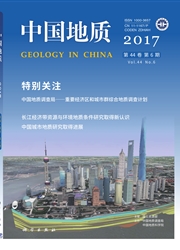

 中文摘要:
中文摘要:
提要:凤凰山花岗闪长岩是铜陵地区出露面积最大的岩体,约10km^2,属高钾钙碱性系列。位于该岩体西北角的朱家山附近ZK66钻孔揭示。岩体超覆于三叠纪碳酸盐岩地层之上。除在浅部见到花岗闪长岩之外,深部主要见到晚泥盆世一二叠纪地层。特别是在石炭纪大理岩中见到辉绿岩和花岗斑岩,其锆石LA—ICP—MSU-Pb年龄分别为304Ma和132Ma,证明本区存在晚古生代岩浆活动,而中生代花岗质岩浆活动可能持续到132Ma。晚石炭世辉绿岩的发现。说明该时期海底是一种拉张环境,海底喷流作用可能与岩浆活动有密切的成因关系,为该时期形成大型矿床奠定了基础。
 英文摘要:
英文摘要:
Abstract:Fenghuangshan granodiorite with an outcropped area of approximately 10 km2 is the largest pluton in Tongling area, belonging to high-K calc-alkaline series. ZK 66 drill hole at Zhujiashan located in the northwest comer of the Fenghuangshan pluton revealed that the pluton overlaps on the top of Triassic carbonate strata. Besides the granodiorite seen in the shallow part of the ZK 66 dril/hole, the Late Devonian-Permian strata can also be found in the depth of the drill hole. Especially, the diabase with an age of 304 Ma and the granite porphyry with an age of 132 Ma were found in the Carboniferous marble, indicating the existence of late Paleozoic magmatism and probably the Mesozoic granite magmatism which lasted until 132Ma. The discovery of the late Carboniferous diabase reveals a sea-floor spreading environment and also indicates the close genetic relationship between the marine exhalation and the magmatism, which laid a solid foundation for the formation of a large ore deposit in that period.
 同期刊论文项目
同期刊论文项目
 同项目期刊论文
同项目期刊论文
 An Early Paleozoic double- subduction model for the North Qilian oceanic plate: evidence from zircon
An Early Paleozoic double- subduction model for the North Qilian oceanic plate: evidence from zircon 期刊信息
期刊信息
